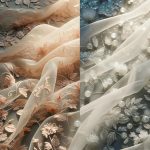If you want to create breathtaking embroidery, selecting the right fabric is essential.
Cotton, linen, silk, velvet, and organza are the top five fabrics renowned for their ability to elevate embroidery to stunning levels.
Each fabric offers unique characteristics that can enhance the beauty and intricacy of your stitches.
Understanding the properties of these fabrics will empower you to choose the most suitable one for your embroidery project.
Whether it's the smooth surface of silk for delicate designs or the luxurious depth of velvet for rich textures, mastering the art of embroidery begins with selecting the perfect fabric.
Explore the top five fabrics for embroidery and unlock the potential to elevate your needlework to new heights.
Key Takeaways
- Cotton fabric is versatile, durable, and easy to work with, making it suitable for both beginners and experienced stitchers.
- Linen fabric provides a crisp and smooth surface for intricate stitching, perfect for creating heirloom pieces.
- Silk offers a luxurious surface and a wide range of embroidery techniques, allowing for exquisite and vibrant designs.
- Velvet's dense pile and rich hues create a striking backdrop for fine, detailed stitching, enhancing the impact of embroidered artwork.
- Organza's transparency and delicate texture add an air of sophistication, allowing for the creation of multi-dimensional and visually captivating designs.
Cotton
When you're choosing fabrics for embroidery, cotton is an excellent option due to its versatility and durability. Cotton embroidery allows for a wide range of stitching techniques, making it suitable for intricate designs as well as simple, elegant patterns. The natural fibers of cotton fabric readily accept dyes, making it easy to find the perfect shade for your project.
When it comes to cotton thread, there's an extensive array of color choices available, allowing you to achieve the exact look you desire. Additionally, cotton thread is known for its strength and smoothness, making it an ideal choice for embroidery work that requires precision and detail.
In cotton embroidery, the fabric itself plays a crucial role in the final outcome. Its ability to hold the stitches firmly and maintain the shape of the design makes it a popular choice among embroidery enthusiasts. Furthermore, cotton fabric is forgiving and easy to work with, making it suitable for both beginners and experienced stitchers.
Whether you're creating a vintage-inspired piece or a modern design, cotton's timeless appeal and practicality make it a top choice for embroidery projects.
Linen
Once you have mastered cotton embroidery, you may want to explore using linen for its unique texture and timeless elegance. Linen, derived from the flax plant, is a popular choice for embroidery due to its natural luster and durability. Linen fabric has a crisp and smooth surface that provides an excellent base for intricate stitching. When working with linen, it's important to use a sharp needle and appropriate embroidery techniques to ensure clean and precise stitches. Due to its natural stiffness, it's advisable to use an embroidery hoop to keep the fabric taut while working on your project.
Linen embroidery techniques often involve delicate and detailed designs, making it ideal for heirloom pieces and fine linens. When embroidering on linen, consider using traditional techniques such as whitework, pulled thread, or cutwork to showcase the fabric's unique characteristics.
In terms of linen fabric care tips, it's essential to wash and dry linen gently to preserve its natural texture and sheen. Hand washing in mild detergent and air drying is recommended to maintain the integrity of the fabric. Additionally, ironing while the fabric is still slightly damp can help achieve a smooth finish without damaging the fibers.
Mastering linen embroidery requires attention to detail and an appreciation for the fabric's inherent beauty and longevity.
Silk
Silk, a luxurious and versatile fabric, offers a smooth and lustrous surface for exquisite embroidery work. When it comes to silk embroidery, there are several key aspects to consider for achieving stunning results:
- Silk Embroidery Techniques: Silk's delicate nature allows for a wide range of embroidery techniques such as satin stitch, split stitch, and French knots. These techniques bring out the sheen and drape of the fabric, enhancing the visual appeal of the embroidery.
- Historical Significance: Silk has a rich historical significance in embroidery, particularly in cultures such as China, where silk embroidery has been practiced for thousands of years. Understanding the historical context can provide valuable insights into traditional silk embroidery styles and motifs.
- Silk Thread and Color Variations: Silk thread, known for its fine texture and vibrant sheen, comes in a diverse range of colors. Its ability to hold dyes exceptionally well allows for creating intricate and vivid designs. Exploring the myriad color variations can add depth and dimension to silk embroidery projects.
Mastering silk embroidery involves a deep appreciation for the fabric's characteristics, historical context, and the creative potential of silk threads.
Velvet
To achieve stunning embroidery, consider exploring the luxurious texture and rich color absorption of velvet, which, like silk, presents unique characteristics for intricate stitching and vibrant designs.
Luxurious velvet, with its dense pile and soft, plush feel, provides a striking backdrop for embroidery. Its ability to hold color makes it a versatile and vibrant fabric for creating intricate designs. The dense weave of velvet allows for fine, detailed stitching, making it ideal for capturing complex patterns and textures.
The rich, deep hues of velvet add depth and dimension to embroidered designs, creating a visually stunning effect. Whether used for traditional or contemporary embroidery styles, velvet's sumptuous appearance elevates the overall impact of the stitched artwork.
When embroidering on velvet, attention to detail is crucial, as the fabric's pile requires careful handling to ensure precise needlework. With its opulent feel and intense color saturation, velvet offers an exquisite canvas for crafting truly mesmerizing embroidered pieces.
Organza
Continuing from the discussion of velvet, consider exploring organza as another fabric with unique characteristics that can enhance the beauty of embroidery.
Organza is a sheer, lightweight fabric that adds an element of sheer elegance to embroidered designs. Its delicate details make it an excellent choice for intricate and finely detailed embroidery work.
Here are three reasons why organza is a top fabric for stunning embroidery:
- Transparency: The sheer quality of organza allows for a play of light and shadow, creating a captivating effect when combined with embroidery. This transparency adds depth and dimension to the embroidered designs, making them visually striking.
- Versatility: Organza is a versatile fabric that can be layered over other materials, such as satin or silk, to create unique textures and effects. This versatility opens up a wide range of creative possibilities for embroidery, allowing for the creation of multi-dimensional and visually captivating designs.
- Elegance: The delicate and refined nature of organza lends an air of sophistication to embroidered pieces. Its light and airy texture, combined with the intricate embroidery, exudes an aura of sheer elegance, making it a fabric of choice for creating stunning and luxurious embroidered creations.
Frequently Asked Questions
What Are the Best Types of Needles to Use for Embroidery on Cotton, Linen, Silk, Velvet, and Organza?
For cotton, linen, silk, velvet, and organza embroidery, the best needle options vary. Fine needles work well for silk and organza, whereas sturdy ones are ideal for velvet. Tailor your embroidery techniques to suit each fabric's unique qualities.
Can These Fabrics Be Easily Dyed or Does the Embroidery Need to Be Done Before Dying?
When dyeing fabrics for embroidery, consider the dyeing process and embroidery techniques. Some fabrics require dyeing before embroidery, while others can be dyed after. Understanding the fabric's properties is crucial for achieving stunning results.
Are There Any Specific Care Instructions for Maintaining Embroidered Pieces Made From These Fabrics?
To maintain embroidered pieces made from these fabrics, follow specific care instructions. Ensure fabric durability by using maintenance tips, and check for color fastness before washing. This will help preserve the stunning embroidery for years to come.
How Do These Fabrics Differ in Terms of Texture and How Does That Affect the Embroidery Process?
When working with different fabrics for embroidery, texture differences affect the embroidery process. Carefully consider fabric care, design considerations, and specific design limitations. Adjust needle types and dyeing process to suit fabric maintenance.
Are There Any Specific Design Considerations or Limitations When Working With These Fabrics for Embroidery?
When working with embroidery on different fabrics, it's essential to consider design elements such as fabric texture and weight. Material limitations may include stretchiness, weave type, and colorfastness, influencing the final embroidery outcome.
- Tetron Fabric for Marine Applications: Durability and Use Cases - June 18, 2025
- Tetron Fabric for Outdoor Furniture: Weather Resistance and Care - June 18, 2025
- Tetron Fabric for Wall Coverings: Style and Application Tips - June 18, 2025







